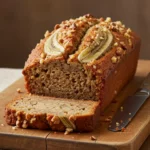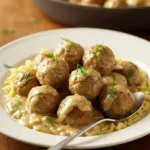Let me tell you, there’s just something magical about roasted garlic. That pungent, sharp aroma transforms in the oven into a sweet, mellow fragrance that promises pure deliciousness. And when you infuse that roasted garlic goodness into creamy, fluffy mashed potatoes? Well, you’ve just created a side dish that’s not just good, it’s unforgettable. My family absolutely devours these Roasted Garlic Mashed Potatoes every time I make them. Even my picky eaters, who usually give side dishes a cursory glance, pile these onto their plates with gusto. The subtle sweetness of the roasted garlic elevates the humble mashed potato to a whole new level of comfort food perfection. Whether it’s a cozy weeknight dinner or a grand holiday feast, these mashed potatoes are always a hit, adding a touch of gourmet flair without any extra fuss. Trust me, once you try these, you’ll never look at mashed potatoes the same way again!
Ingredients
This recipe utilizes simple, readily available ingredients, focusing on quality to bring out the best flavors. Each ingredient plays a crucial role in creating the ultimate roasted garlic mashed potato experience.
- 1 Whole Head of Garlic: The star of the show! A whole head of garlic is essential for that deep, roasted garlic flavor. Don’t be tempted to use pre-minced garlic or garlic powder – the roasting process is what unlocks the unique sweetness and mellows the sharpness of raw garlic, creating a completely different flavor profile. Look for a firm, plump head of garlic without any soft spots or blemishes. The size of the head isn’t critical, but ensure it’s a standard-sized head to get the right amount of roasted garlic for the potato quantity.
- 2 lbs Yukon Gold Potatoes, Diced: Yukon Gold potatoes are the ideal choice for mashed potatoes due to their naturally buttery flavor and creamy texture. They are not overly starchy, which helps prevent the mashed potatoes from becoming gummy. Their slightly waxy texture ensures they hold their shape well while boiling, and they mash beautifully into a smooth, velvety consistency. While Yukon Golds are preferred, you can substitute with Russet potatoes if needed. However, Russets are starchier and may require a little more liquid and careful mashing to avoid a gluey texture. Dicing the potatoes into 1-inch cubes ensures even cooking and faster boiling time. Uniformly sized pieces are key to potatoes cooking at the same rate.
- 6 Tablespoons Butter: Butter is crucial for richness and flavor in mashed potatoes. Use unsalted butter to control the saltiness of the final dish. The butter adds a luxurious creaminess and a beautiful sheen to the potatoes. You can use salted butter, but be sure to adjust the added salt accordingly, tasting as you go. For an even richer flavor, consider using European-style butter, which has a higher butterfat content.
- ½ cup Heavy Cream: Heavy cream is the secret to incredibly creamy and decadent mashed potatoes. It adds moisture, richness, and a luxurious texture that milk or half-and-half simply can’t replicate. The high fat content of heavy cream contributes to a smooth, velvety consistency and prevents the potatoes from drying out. If you want a slightly lighter version, you can substitute with half-and-half, but the texture will be less rich. Avoid using skim milk or low-fat milk, as they will make the mashed potatoes watery and less flavorful.
- Salt & Pepper to Taste: Seasoning is paramount to bringing out the flavors of all the ingredients. Salt enhances the natural sweetness of the potatoes and roasted garlic, while pepper adds a subtle warmth and depth. Use kosher salt or sea salt for the best flavor. Freshly ground black pepper is preferred over pre-ground pepper for its brighter, more aromatic flavor. Start with a teaspoon of salt and a half teaspoon of pepper, and then adjust to your taste. Remember, you can always add more seasoning, but you can’t take it away.
Instructions
Follow these step-by-step instructions to create perfectly roasted garlic mashed potatoes. Each step is designed to maximize flavor and ensure a creamy, fluffy texture.
- Roast the Garlic to Golden Perfection: Begin by preparing the garlic. Preheat your oven to 400 degrees Fahrenheit (200 degrees Celsius). Take the whole head of garlic and, using a sharp knife, carefully slice off the top quarter to half inch of the head. This exposes the individual garlic cloves within. Drizzle approximately 1 teaspoon of olive oil over the exposed cloves, ensuring the oil penetrates into the crevices. Wrap the entire garlic head tightly in aluminum foil. This creates a steam environment that helps the garlic roast and become incredibly tender and sweet. Place the foil-wrapped garlic head directly on the oven rack or on a baking sheet. Roast for 50 minutes to 1 hour, or until the garlic cloves are soft and caramelized, and the aroma fills your kitchen with a heavenly scent. The roasting time may vary slightly depending on the size and freshness of the garlic, so check for doneness by gently squeezing the head – the cloves should feel very soft. Once roasted, remove the garlic from the oven and let it cool slightly while you prepare the potatoes. The roasted garlic can be prepared ahead of time and stored in the refrigerator for a few days until ready to use.
- Boil the Potatoes to Fork-Tender Softness: While the garlic is roasting, prepare the potatoes. Wash the Yukon Gold potatoes thoroughly under cold running water to remove any dirt or debris. Dice the potatoes into uniform 1-inch cubes. Consistent size is crucial for even cooking. Place the diced potatoes in a large pot. Cover the potatoes with cold water, ensuring the water level is about an inch or so above the potatoes. Starting with cold water helps the potatoes cook evenly from the inside out. Add a generous pinch of salt to the water – this seasons the potatoes from the inside and enhances their flavor. Bring the pot to a rolling boil over high heat. Once boiling, reduce the heat to medium and continue to boil for 15-20 minutes, or until the potatoes are fork-tender. You’ll know they’re ready when a fork easily pierces through a potato cube without resistance. Avoid overcooking, as this can make the potatoes waterlogged and less flavorful. Drain the potatoes immediately in a colander to remove all the water and prevent them from becoming soggy.
- Choose Your Masher and Get Ready to Mash: Now it’s time to mash those perfectly cooked potatoes! Transfer the drained potatoes to a large mixing bowl. You have several options for mashing, each yielding slightly different results. For a rustic, slightly chunky texture, a hand masher works wonderfully. For a smoother, creamier consistency, an electric hand mixer or a stand mixer fitted with the paddle attachment is ideal. A potato ricer creates the fluffiest, most lump-free mashed potatoes, but requires a bit more effort. If using a stand mixer, be cautious not to overmix, as this can lead to gummy potatoes. No matter your chosen method, the key is to mash while the potatoes are still hot, as they mash more easily when warm.
- Infuse Creaminess with Butter and Heavy Cream: While the potatoes are mashing, prepare the butter and heavy cream mixture. In a medium saucepan, combine the 6 tablespoons of butter and ½ cup of heavy cream. Heat over low heat until the butter is completely melted and the cream is warmed through. Do not boil the cream. Warming the dairy ingredients helps them incorporate smoothly into the mashed potatoes and keeps the potatoes warm. Once melted, pour the warm butter and cream mixture over the mashed potatoes in the bowl.
- Unleash the Roasted Garlic Flavor and Mash to Perfection: By now, the roasted garlic should be cool enough to handle. Carefully squeeze the roasted garlic cloves out of their skins. The roasted garlic will be incredibly soft and will easily slip out. You can squeeze the cloves directly into the bowl with the mashed potatoes for a more pronounced garlic flavor and slightly larger pieces of roasted garlic. Alternatively, for a smoother, more evenly distributed garlic flavor, you can mash the roasted garlic cloves in a small bowl with a fork before adding them to the potatoes. This creates a roasted garlic paste that blends seamlessly into the mashed potatoes. Add the roasted garlic to the potatoes along with salt and pepper to taste. Begin with about 1 teaspoon of salt and ½ teaspoon of black pepper, and then adjust to your preference. Using your chosen mashing method, gently mix all the ingredients together until the potatoes are mashed and creamy. Be careful not to overmix! Overmixing can release too much starch from the potatoes, resulting in a gummy or gluey texture. Mash just until everything is combined and the potatoes are smooth and creamy. Taste and adjust seasoning as needed, adding more salt and pepper to taste.
- Serve and Enjoy the Comfort: Transfer the roasted garlic mashed potatoes to a serving bowl. Garnish with a pat of butter, a sprinkle of fresh herbs like chopped chives or parsley, or a drizzle of olive oil, if desired. Serve immediately while hot and creamy. Roasted Garlic Mashed Potatoes are the perfect side dish to complement a wide variety of main courses. They are especially delicious with roasted meats, poultry, fish, or vegetarian dishes. For an extra touch of indulgence, serve with gravy. These mashed potatoes are also wonderful reheated. Store leftovers in an airtight container in the refrigerator for up to 3 days. Reheat gently in the microwave or on the stovetop with a splash of milk or cream to restore their creamy texture.
Nutrition Facts
This nutritional information is an estimate and may vary based on specific ingredients and portion sizes.
Servings: 6
Calories per serving (estimated): Approximately 320-380 calories
- Fat: 20-25g (primarily from butter and heavy cream)
- Saturated Fat: 12-15g
- Cholesterol: 70-80mg
- Sodium: Varies based on salt added
- Carbohydrates: 35-40g (primarily from potatoes)
- Fiber: 3-4g
- Sugar: 3-5g (naturally occurring in potatoes and garlic)
- Protein: 4-5g
These mashed potatoes are a relatively calorie-dense side dish due to the butter and heavy cream. However, they are also a source of carbohydrates, some fiber, and a small amount of protein. Enjoy in moderation as part of a balanced meal.
Preparation Time
- Prep Time: 5 minutes (This includes dicing the potatoes and prepping the garlic for roasting.)
- Cook Time: 1 hour (This encompasses the 50 minutes for roasting the garlic and 20 minutes for boiling the potatoes. The mashing process is also included in cook time as it happens while potatoes are hot.)
- Total Time: 1 hour 5 minutes
While the total time might seem a bit longer due to the garlic roasting, the active preparation time is minimal. Most of the time is hands-off while the garlic roasts and potatoes boil, making this a relatively easy side dish to prepare alongside other meal components.
How to Serve Roasted Garlic Mashed Potatoes
These versatile mashed potatoes are the perfect accompaniment to countless dishes. Here are some delicious ways to serve them:
- Classic Comfort Side: Serve alongside roasted chicken, pot roast, meatloaf, or steak for a classic comfort food meal. The creamy mashed potatoes perfectly complement rich, savory main courses.
- Holiday Feast Staple: Roasted Garlic Mashed Potatoes are an elegant and flavorful addition to any holiday table, from Thanksgiving and Christmas to Easter and beyond. They pair beautifully with turkey, ham, prime rib, and other festive main dishes.
- Gravy’s Best Friend: A generous ladle of your favorite gravy – whether it’s classic brown gravy, mushroom gravy, or even a creamy white gravy – poured over these mashed potatoes is pure indulgence. The roasted garlic flavor enhances the richness of the gravy.
- Vegetarian Delight: Serve as a base for vegetarian dishes like lentil loaf, mushroom Wellington, or alongside roasted vegetables like asparagus, broccoli, or Brussels sprouts. The creamy potatoes add substance and flavor to vegetarian meals.
- Shepherd’s Pie Topping: Elevate your shepherd’s pie by using Roasted Garlic Mashed Potatoes as the topping instead of plain mashed potatoes. The roasted garlic adds a depth of flavor that takes shepherd’s pie to the next level.
- Breakfast for Dinner (Brinner): Top with a fried egg and some crispy bacon or sausage for a comforting and satisfying “breakfast for dinner” option. The creamy potatoes and roasted garlic create a delicious base for savory breakfast toppings.
Additional Tips for Perfect Roasted Garlic Mashed Potatoes
Elevate your mashed potato game with these helpful tips and tricks:
- Don’t Overmix: The cardinal rule of mashed potatoes! Overmixing releases too much starch, resulting in gummy, gluey potatoes. Mash just until smooth and creamy, stopping as soon as the ingredients are combined.
- Warm Your Dairy: Always warm your butter and heavy cream (or milk) before adding them to the potatoes. Cold dairy can cool down the potatoes and make them less creamy. Warming the dairy helps it incorporate seamlessly and maintain the temperature and texture of the mashed potatoes.
- Salt the Potato Water Generously: Salting the water while boiling potatoes is essential for seasoning them from the inside out. Don’t be shy with the salt – it enhances the natural flavor of the potatoes and prevents them from tasting bland.
- Use a Potato Ricer for Extra Fluffiness: For the ultimate in fluffy, lump-free mashed potatoes, invest in a potato ricer. Ricing the potatoes creates a light and airy texture that’s simply divine.
- Infuse Extra Flavor: Get creative with flavor additions! Try adding fresh herbs like rosemary, thyme, or chives to the mashed potatoes. You can also incorporate grated Parmesan cheese, sour cream, cream cheese, or even crispy bacon bits for extra layers of flavor and texture.
Frequently Asked Questions (FAQ)
Q1: Can I use milk instead of heavy cream?
A: Yes, you can substitute milk or half-and-half for heavy cream if you want a lighter version. However, keep in mind that the mashed potatoes will be less rich and creamy. Heavy cream provides a significantly richer texture and flavor due to its higher fat content. If using milk, opt for whole milk for the best results and avoid skim milk, which will make the potatoes watery.
Q2: Can I roast the garlic in advance?
A: Absolutely! Roasting the garlic in advance is a great time-saving tip. Roasted garlic can be stored in an airtight container in the refrigerator for up to 3-4 days. You can even roast a larger batch of garlic and use it in various recipes throughout the week. When you’re ready to make the mashed potatoes, simply squeeze out the roasted cloves.
Q3: What if I don’t have Yukon Gold potatoes? Can I use other types?
A: While Yukon Gold potatoes are highly recommended for their creamy texture and buttery flavor, you can use other types of potatoes. Russet potatoes are a common alternative, but they are starchier and tend to absorb more liquid. If using Russets, be careful not to overmix them, and you may need to add a bit more butter and cream to achieve the desired creamy consistency. Red potatoes are waxier and will result in denser mashed potatoes, but they can also be used if that’s your preference. Avoid using fingerling potatoes as they are too waxy for traditional mashed potatoes.
Q4: How can I reheat leftover mashed potatoes without them drying out?
A: Reheating mashed potatoes can sometimes result in a dry texture. To prevent this, add a splash of milk, heavy cream, or even broth when reheating. Reheat gently in the microwave in short intervals, stirring in between, or on the stovetop over low heat, stirring frequently and adding liquid as needed to restore their creamy consistency. Avoid overheating, as this can make them dry and grainy.
Q5: Can I freeze roasted garlic mashed potatoes?
A: While mashed potatoes can be frozen, their texture may change slightly upon thawing and reheating, sometimes becoming a bit grainy. For best results, freeze them in an airtight container or freezer bags in portion sizes. When thawing, thaw overnight in the refrigerator. Reheat gently using the methods described above, adding liquid to restore creaminess. For optimal quality, it’s generally recommended to make mashed potatoes fresh, but freezing is a viable option for leftovers or make-ahead convenience.

Roasted Garlic Mashed Potatoes Recipe
Ingredients
- 1 Whole Head of Garlic: The star of the show! A whole head of garlic is essential for that deep, roasted garlic flavor. Don’t be tempted to use pre-minced garlic or garlic powder – the roasting process is what unlocks the unique sweetness and mellows the sharpness of raw garlic, creating a completely different flavor profile. Look for a firm, plump head of garlic without any soft spots or blemishes. The size of the head isn’t critical, but ensure it’s a standard-sized head to get the right amount of roasted garlic for the potato quantity.
- 2 lbs Yukon Gold Potatoes, Diced: Yukon Gold potatoes are the ideal choice for mashed potatoes due to their naturally buttery flavor and creamy texture. They are not overly starchy, which helps prevent the mashed potatoes from becoming gummy. Their slightly waxy texture ensures they hold their shape well while boiling, and they mash beautifully into a smooth, velvety consistency. While Yukon Golds are preferred, you can substitute with Russet potatoes if needed. However, Russets are starchier and may require a little more liquid and careful mashing to avoid a gluey texture. Dicing the potatoes into 1-inch cubes ensures even cooking and faster boiling time. Uniformly sized pieces are key to potatoes cooking at the same rate.
- 6 Tablespoons Butter: Butter is crucial for richness and flavor in mashed potatoes. Use unsalted butter to control the saltiness of the final dish. The butter adds a luxurious creaminess and a beautiful sheen to the potatoes. You can use salted butter, but be sure to adjust the added salt accordingly, tasting as you go. For an even richer flavor, consider using European-style butter, which has a higher butterfat content.
- ½ cup Heavy Cream: Heavy cream is the secret to incredibly creamy and decadent mashed potatoes. It adds moisture, richness, and a luxurious texture that milk or half-and-half simply can’t replicate. The high fat content of heavy cream contributes to a smooth, velvety consistency and prevents the potatoes from drying out. If you want a slightly lighter version, you can substitute with half-and-half, but the texture will be less rich. Avoid using skim milk or low-fat milk, as they will make the mashed potatoes watery and less flavorful.
- Salt & Pepper to Taste: Seasoning is paramount to bringing out the flavors of all the ingredients. Salt enhances the natural sweetness of the potatoes and roasted garlic, while pepper adds a subtle warmth and depth. Use kosher salt or sea salt for the best flavor. Freshly ground black pepper is preferred over pre-ground pepper for its brighter, more aromatic flavor. Start with a teaspoon of salt and a half teaspoon of pepper, and then adjust to your taste. Remember, you can always add more seasoning, but you can’t take it away.
Instructions
- Roast the Garlic to Golden Perfection: Begin by preparing the garlic. Preheat your oven to 400 degrees Fahrenheit (200 degrees Celsius). Take the whole head of garlic and, using a sharp knife, carefully slice off the top quarter to half inch of the head. This exposes the individual garlic cloves within. Drizzle approximately 1 teaspoon of olive oil over the exposed cloves, ensuring the oil penetrates into the crevices. Wrap the entire garlic head tightly in aluminum foil. This creates a steam environment that helps the garlic roast and become incredibly tender and sweet. Place the foil-wrapped garlic head directly on the oven rack or on a baking sheet. Roast for 50 minutes to 1 hour, or until the garlic cloves are soft and caramelized, and the aroma fills your kitchen with a heavenly scent. The roasting time may vary slightly depending on the size and freshness of the garlic, so check for doneness by gently squeezing the head – the cloves should feel very soft. Once roasted, remove the garlic from the oven and let it cool slightly while you prepare the potatoes. The roasted garlic can be prepared ahead of time and stored in the refrigerator for a few days until ready to use.
- Boil the Potatoes to Fork-Tender Softness: While the garlic is roasting, prepare the potatoes. Wash the Yukon Gold potatoes thoroughly under cold running water to remove any dirt or debris. Dice the potatoes into uniform 1-inch cubes. Consistent size is crucial for even cooking. Place the diced potatoes in a large pot. Cover the potatoes with cold water, ensuring the water level is about an inch or so above the potatoes. Starting with cold water helps the potatoes cook evenly from the inside out. Add a generous pinch of salt to the water – this seasons the potatoes from the inside and enhances their flavor. Bring the pot to a rolling boil over high heat. Once boiling, reduce the heat to medium and continue to boil for 15-20 minutes, or until the potatoes are fork-tender. You’ll know they’re ready when a fork easily pierces through a potato cube without resistance. Avoid overcooking, as this can make the potatoes waterlogged and less flavorful. Drain the potatoes immediately in a colander to remove all the water and prevent them from becoming soggy.
- Choose Your Masher and Get Ready to Mash: Now it’s time to mash those perfectly cooked potatoes! Transfer the drained potatoes to a large mixing bowl. You have several options for mashing, each yielding slightly different results. For a rustic, slightly chunky texture, a hand masher works wonderfully. For a smoother, creamier consistency, an electric hand mixer or a stand mixer fitted with the paddle attachment is ideal. A potato ricer creates the fluffiest, most lump-free mashed potatoes, but requires a bit more effort. If using a stand mixer, be cautious not to overmix, as this can lead to gummy potatoes. No matter your chosen method, the key is to mash while the potatoes are still hot, as they mash more easily when warm.
- Infuse Creaminess with Butter and Heavy Cream: While the potatoes are mashing, prepare the butter and heavy cream mixture. In a medium saucepan, combine the 6 tablespoons of butter and ½ cup of heavy cream. Heat over low heat until the butter is completely melted and the cream is warmed through. Do not boil the cream. Warming the dairy ingredients helps them incorporate smoothly into the mashed potatoes and keeps the potatoes warm. Once melted, pour the warm butter and cream mixture over the mashed potatoes in the bowl.
- Unleash the Roasted Garlic Flavor and Mash to Perfection: By now, the roasted garlic should be cool enough to handle. Carefully squeeze the roasted garlic cloves out of their skins. The roasted garlic will be incredibly soft and will easily slip out. You can squeeze the cloves directly into the bowl with the mashed potatoes for a more pronounced garlic flavor and slightly larger pieces of roasted garlic. Alternatively, for a smoother, more evenly distributed garlic flavor, you can mash the roasted garlic cloves in a small bowl with a fork before adding them to the potatoes. This creates a roasted garlic paste that blends seamlessly into the mashed potatoes. Add the roasted garlic to the potatoes along with salt and pepper to taste. Begin with about 1 teaspoon of salt and ½ teaspoon of black pepper, and then adjust to your preference. Using your chosen mashing method, gently mix all the ingredients together until the potatoes are mashed and creamy. Be careful not to overmix! Overmixing can release too much starch from the potatoes, resulting in a gummy or gluey texture. Mash just until everything is combined and the potatoes are smooth and creamy. Taste and adjust seasoning as needed, adding more salt and pepper to taste.
- Serve and Enjoy the Comfort: Transfer the roasted garlic mashed potatoes to a serving bowl. Garnish with a pat of butter, a sprinkle of fresh herbs like chopped chives or parsley, or a drizzle of olive oil, if desired. Serve immediately while hot and creamy. Roasted Garlic Mashed Potatoes are the perfect side dish to complement a wide variety of main courses. They are especially delicious with roasted meats, poultry, fish, or vegetarian dishes. For an extra touch of indulgence, serve with gravy. These mashed potatoes are also wonderful reheated. Store leftovers in an airtight container in the refrigerator for up to 3 days. Reheat gently in the microwave or on the stovetop with a splash of milk or cream to restore their creamy texture.
Nutrition
- Serving Size: One Normal Portion
- Calories: 320-380
- Sugar: 3-5g
- Sodium: 70-80mg
- Saturated Fat: 12-15g
- Carbohydrates: 35-40g
- Fiber: 3-4g
- Protein: 4-5g





